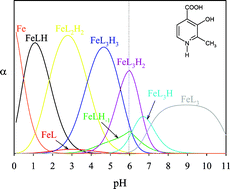Evaluation of 2-methyl-3-hydroxy-4-pyridinecarboxylic acid as a possible chelating agent for iron and aluminium
Abstract
In view of a possible application to Fe and Al chelation therapy,

* Corresponding authors
a
Dipartimento di Scienze Chimiche, Università di Padova, via Marzolo 1, Padova, Italy
E-mail:
valerio.dimarco@unipd.it
b Dipartimento di Scienze Farmaceutiche, Università of Padova, via Marzolo 5, Padova, Italy
c Dipartimento di Istologia, Microbiologia e Biotecnologie Mediche, via Gabelli 63, Padova, Italy
d CNR, Istituto di Scienze e Tecnologie Molecolari, via Marzolo 1, Padova, Italy
In view of a possible application to Fe and Al chelation therapy,

 Please wait while we load your content...
Something went wrong. Try again?
Please wait while we load your content...
Something went wrong. Try again?
A. Dean, M. G. Ferlin, P. Brun, I. Castagliuolo, D. Badocco, P. Pastore, A. Venzo, G. G. Bombi and V. B. Di Marco, Dalton Trans., 2008, 1689 DOI: 10.1039/B717269A
To request permission to reproduce material from this article, please go to the Copyright Clearance Center request page.
If you are an author contributing to an RSC publication, you do not need to request permission provided correct acknowledgement is given.
If you are the author of this article, you do not need to request permission to reproduce figures and diagrams provided correct acknowledgement is given. If you want to reproduce the whole article in a third-party publication (excluding your thesis/dissertation for which permission is not required) please go to the Copyright Clearance Center request page.
Read more about how to correctly acknowledge RSC content.
 Fetching data from CrossRef.
Fetching data from CrossRef.
This may take some time to load.
Loading related content
